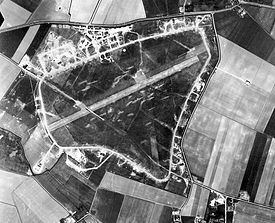Type Military airfield In use 1940-1946 Owner Air Ministry | Code IM Year built 1940 | |
 | ||
Controlled by Royal Air ForceUnited States Army Air Forces Battles/wars European Theatre of World War IIAir Offensive, Europe July 1942 - May 1945 Garrisons RAF Fighter Command, 361st Fighter Group | ||
Royal Air Force Bottisham or more simply RAF Bottisham is a former Royal Air Force station located 5 miles (8.0 km) east of Cambridge, Cambridgeshire, England.
Contents
RAF Fighter Command use
RAF Bottisham opened in March 1940 and was first used by bomb-armed de Havilland Tiger Moths transferred from No. 22 Elementary Flying Training School RAF (EFTS) to be prepared for possible anti-invasion duties. Then beginning in October 1940, the airfield was used by 22 EFTS Tiger Moths as an Relief Landing Ground until mid-1941.
With the departure of the Tiger Moths, Bottisham was transferred to 241 Sqn Army Co-operation Command with Westland Lysanders, Curtiss Tomahawks, North American Mustang Mk 1's, moved to Ayr.
From 15 June 1942, the airfield was used by No. 652 Squadron RAF and No. 168 Squadron RAF.
A number of other Royal Air Force squadrons used the airfield before it was turned over to the United States Army Air Forces:
United States Army Air Forces use
With the arrival of large numbers of USAAF fighter groups in 1943, Bottisham was allocated to the Americans and assigned designation as Station 374 (IM). The airfield was enlarged and areas of steel matting were laid.
USAAF Station Units assigned to RAF Bottisham were:
361st Fighter Group
The airfield was first used by the United States Army Air Forces Eighth Air Force 361st Fighter Group, arriving from Richmond AAF, Virginia on 30 November 1943. The group was under the command of the 65th Fighter Wing of the VIII Fighter Command. Aircraft of the group were identified by yellow around their cowlings and tails.
The group consisted of the following squadrons:
The 361st FG entered combat with Republic P-47 Thunderbolt aircraft on 21 January 1944 and converted to North American P-51 Mustang's in May 1944. The unit served primarily as an escort organization, covering the penetration, attack, and withdrawal of Boeing B-17 Flying Fortress/Consolidated B-24 Liberator bomber formations that the USAAF sent against targets on the Continent.
The group also engaged in counter-air patrols, fighter sweeps, and strafing and dive-bombing missions. It attacked such targets as airdromes, marshalling yards, missile sites, industrial areas, ordnance depots, oil refineries, trains, and highways. It participated in the assault against the German Air Force and aircraft industry during Big Week, 20–25 February 1944; the Normandy invasion, June 1944 and the Saint-Lô breakthrough in July.
The weight of the heavy P-47 fighters soon began to tell on the wet surface making take-offs tricky. A team of American engineers were called in during January 1944 and, in three days, they constructed a 1,470-yard-long runway with pierced-steel planking. This feat was considered a record for laying this type of prefabricated surfacing. The runway, which was aligned NE-SW, became the main at Bottisham the other also being constructed of P5P.
In September 1944 the 361st FG moved to RAF Little Walden when it became available after the departure of the 409th Bombardment Group (Light) for France. Little Walden was a Class A airfield with concrete runways and much better facilities than were available at Bottisham.
Post-war use
From mid-1945 until 5 January 1946 Bottisham was used temporarily by Belgian airmen until being closed. Today, few traces of Bottisham remain as the land has all been reclaimed for farming, however a few buildings remain in use. The outline of the PSP runway can still be seen, but nowas a long thick row of trees. Also the track which intersected the PSP runway towards the SW end is now a permanent Road which cuts through this row of trees.
